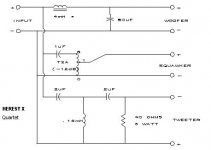Hi,
The attached schematic is of a Klipsch Quartet cross-over.
I'm new to loudspeaker crossovers and need a bit of assistance identifying which types of filters were used here.
To my understanding, for the woofer, there is a LPF consisting of an inductor in series and cap in parallel.
For the tweeter, there is a HPF consisting of a cap and inductor, then cap and resistor.
What are the "names" or types of these ? I would to understand how the different values determine the frequency cut-off.
Thanks
The attached schematic is of a Klipsch Quartet cross-over.
I'm new to loudspeaker crossovers and need a bit of assistance identifying which types of filters were used here.
To my understanding, for the woofer, there is a LPF consisting of an inductor in series and cap in parallel.
For the tweeter, there is a HPF consisting of a cap and inductor, then cap and resistor.
What are the "names" or types of these ? I would to understand how the different values determine the frequency cut-off.
Thanks
Attachment?
Sounds like a simple crossover arrangement which is as you describe, but with added impedance compensation on the tweeter.
A comprehensive guide is available here: The Crossover Design Cookbook
And a simpler introduction here: Passive Crossover Slopes
Sounds like a simple crossover arrangement which is as you describe, but with added impedance compensation on the tweeter.
A comprehensive guide is available here: The Crossover Design Cookbook
And a simpler introduction here: Passive Crossover Slopes
Last edited:
Nothing attached, but I'm familiar with the schematic.
Low pass is a 2nd order electrical, high pass on the tweeter is a 3rd order electrical with a damping shunt resistor.
Note that the electrical and acoustical orders of a crossover slope are rarely (almost never) the same.
Low pass is a 2nd order electrical, high pass on the tweeter is a 3rd order electrical with a damping shunt resistor.
Note that the electrical and acoustical orders of a crossover slope are rarely (almost never) the same.
Sorry... attached now.
Thanks Galu and Scott for the quick replies.
I will look into it further based on this info
Thanks Galu and Scott for the quick replies.
Low pass is a 2nd order electrical, high pass on the tweeter is a 3rd order electrical with a damping shunt resistor.
I will look into it further based on this info
Attachments
Aha. That is the kind of crossover that Klipsch must have tinkered with for decades.*
And it is just the sort of thing you might simulate or implement with a DSP. I say that because it is rather a mix-and-match of slopes, loudness control, and XO points, I'd guess.
Designing a crossover is just a wild guess until you test it and esp to test it in your room. So it makes sense to "breadboard" the crossover and the easiest way to do that is to borrow or buy a Behringer DSP.
BTW, a 40-Ohm resistor isn't doing much damping. They must have thrown it in to adjust loudness or curve.... risky trying to predict how loud the tweeter will sound to you before you try the speaker in your room.
B.
* great man, great bass horn
And it is just the sort of thing you might simulate or implement with a DSP. I say that because it is rather a mix-and-match of slopes, loudness control, and XO points, I'd guess.
Designing a crossover is just a wild guess until you test it and esp to test it in your room. So it makes sense to "breadboard" the crossover and the easiest way to do that is to borrow or buy a Behringer DSP.
BTW, a 40-Ohm resistor isn't doing much damping. They must have thrown it in to adjust loudness or curve.... risky trying to predict how loud the tweeter will sound to you before you try the speaker in your room.
B.
* great man, great bass horn
Last edited:
How crucial is the value of the cap on the low-pass of the woofer?
The schematic is a bit smeared, but it seems to be 50uf or 60uf.
When I opened the speaker, there is actually an 80uf inside.
The speakers are close to 30 years old so I would like to refresh the caps in there.
Mouser/Digikey have bipolar radial caps but only in values 68uf and 100uf.
Otherwise some other parts suppliers have 80-82uf caps, but those are axial and I may have to be creative with the leads.
The schematic is a bit smeared, but it seems to be 50uf or 60uf.
When I opened the speaker, there is actually an 80uf inside.
The speakers are close to 30 years old so I would like to refresh the caps in there.
Mouser/Digikey have bipolar radial caps but only in values 68uf and 100uf.
Otherwise some other parts suppliers have 80-82uf caps, but those are axial and I may have to be creative with the leads.
- Home
- Loudspeakers
- Multi-Way
- What type of filter is this ?
